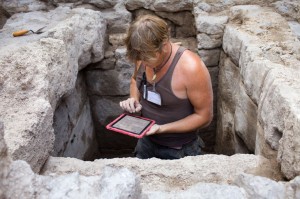As much as technology from DNA testing to satellite imaging has had a profound impact on the practice of archaeology, some of the most basic elements of field work have remained the same for hundreds of years. Recording the excavation site is still primarily a pen-and-paper operation; only later are the handwritten notes entered into software like CAD and Harris Matrix builders.
It’s a huge amount of note-taking. The forms describing soil layers and features can reach into the hundreds for a single trench. Then there are the elevation recordings, scaled drawings of the trench which have to be made every day to show the changes as the excavation proceeds, plus the on-site Harris Matrices that establish the relative ages of the layers. Sharing updated information can be a challenge, needless to say, but even in an era of portable computing, pen-and-paper has persisted as standard practice. Laptops have a lot of moving parts that don’t respond well to trenches full of dirt, and electricity is always a challenge in the field.
 The iPad solves both of those problems, and has the added boost of lots of apps that fit archaeological needs like a glove. It’s easily portable (even more so than pen and paper because you don’t need a writing surface or a writing implement), has no moving parts to get impacted with dirt, and the battery lasts the whole day. Plus, you have the entire Internet at your fingers for your on-the-spot research needs. The University of Cincinnati’s Pompeii team is putting 6 iPads through their paces in their excavation of a neighborhood off Pompeii’s main street.
The iPad solves both of those problems, and has the added boost of lots of apps that fit archaeological needs like a glove. It’s easily portable (even more so than pen and paper because you don’t need a writing surface or a writing implement), has no moving parts to get impacted with dirt, and the battery lasts the whole day. Plus, you have the entire Internet at your fingers for your on-the-spot research needs. The University of Cincinnati’s Pompeii team is putting 6 iPads through their paces in their excavation of a neighborhood off Pompeii’s main street.
“It was the ability to enter so many disparate kinds of information, recording everything from architectural elements to fish scales and bones to the actual sequences of events. That my team could both type and draw on the screen, and also examine all previously entered data, made it an ideal single-device solution.”
With iPad, [University of Cincinnati’s archaeological databases expert John] Wallrodt was able to re-create each of [the pen-and-paper] functions using “off-the-shelf” apps from the App Store. FMTouch replaced paper forms by allowing researchers to make direct entries into their database forms on iPad. The Pages app supplanted paper notebooks, enabling them to not only enter notations on the iPad keyboard but also import drawings and photos. Scaled drawings were made directly on iPad in iDraw. And OmniGraffle handled the intricate matrix illustrations.
“iPad replaced all of these functions and added many others,” says Wallrodt. “In this way, all of our piles of paper were replaced with a single 1.5-pound device.”
Dr. Steven Ellis, director of the University of Cincinnati’s Pompeii excavation, estimates that the 6 onsite iPads have spared him a year of data entry already. He plans to double the number of them so there are 2 per trench. He thinks iPads in the field are going to be as big a leap forward as the introduction of computers to crunch data were 30 years ago.
“The recovery of invaluable information from our Pompeian excavations is now incalculably faster, wonderfully easier, unimaginably more dynamic, precisely more accurate, and robustly secure,” he says.
Interesting, thank you kindly. I wish the English option on the CEEH’s website actually translated something besides the headlines, because I’d love to browse it without having to make do with my 1 year of college Spanish.